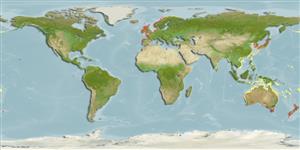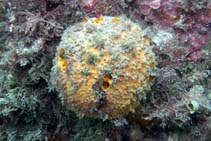Tethya aurantium (Pallas, 1766)
Ball sponge| Native range | All suitable habitat | Point map | Year 2050 |

|
| This map was computer-generated and has not yet been reviewed. |
| Tethya aurantium AquaMaps Data sources: GBIF OBIS |
Classification / Names Common names | Synonyms | CoL | ITIS | WoRMS
Demospongiae | Tethyida | Tethyidae
Environment: milieu / climate zone / depth range / distribution range Ecology
Sessile. Temperate
Distribution Countries | FAO areas | Ecosystems | Occurrences | Introductions
Northeast Atlantic and Indo-West Pacific.
Length at first maturity / Size / Weight / Age
Maturity: Lm ? range ? - ? cm
Short description Morphology
Rounded elevations and depressions on surface, with elevations echinated by the spicules. Tesselation absent. Megasclere: rounded base; apex usually blunt but sometimes sharp; styli faintly tylote, no oxea nor strongyla. Microsclere: very small chiasters; larger and more massive spherasters. Chiasters are most abundant at the surface, forming a close layer, rays: 6 to 9. Spherasters rarely spined; unevenly scattered through the ectosome; rare in the choanosome.
Life cycle and mating behavior Maturity | Reproduction | Spawning | Eggs | Fecundity | Larvae
Members of the class Demospongiae are hermaphroditic. Life cycle: The zygote develops into parenchymella larva (free-swimming) before settling down on a substrate where it grows into a young sponge.
Main reference
References | Coordinator | Collaborators
Hooper, J.N.A., J.A. Kennedy and R.W.M. van Soest. 2000. (Ref. 81108)
IUCN Red List Status (Ref. 130435: Version 2024-1)
CITES status (Ref. 108899)
Not Evaluated
CMS (Ref. 116361)
Not Evaluated
Threat to humans
Human uses
| FishSource |
Tools
More information
Trophic Ecology
Food items
Diet
Food consumption
Ration
Predators
Diet
Food consumption
Ration
Predators
Ecology
Population dynamics
Growth
Age/Size
Length-weight
Length-length
Length-frequencies
Mass conversion
Recruitment
Abundance
Age/Size
Length-weight
Length-length
Length-frequencies
Mass conversion
Recruitment
Abundance
Life cycle
Distribution
Human Related
Aquaculture profile
Stamps, Coins Misc.
Stamps, Coins Misc.
Outreach
References
Internet sources
BHL | BOLD Systems | CISTI | DiscoverLife | FAO(Publication : search) | Fishipedia | GenBank (genome, nucleotide) | GloBI | Gomexsi | Google Books | Google Scholar | Google | PubMed | Tree of Life | Wikipedia (Go, Search) | Zoological Record
Estimates based on models
Preferred temperature
(Ref. 115969): 10 - 13.2, mean 11.5 (based on 186 cells).
Price category
(Ref. 80766):
Unknown.



